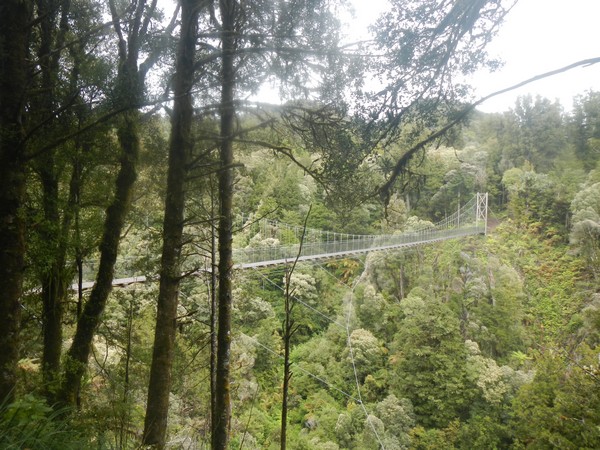
After hiking over the volcanic heart of New Zealand on the Tongariro Crossing, a hike that many consider to be the best 1 day walk in the country, it was time to get back on the bike and head for the jewel in the crown of mountain bike tracks on the North Island – The Timber Trail.
The Timber Trail is a 82km off road mecca for mountain bikers which takes two days to complete as the track winds it’s way through Pureora Forest from it’s start at Pureora Village. Yet again though, I would be doing it the wrong way and instead of descending down the mountain from Pureora Village I would be climbing up it.
The end of the trail, or trail head for me, was located in Ongarue which was a full days ride from where I was in Tongariro National Park. However, that morning I had been up at 4.30am to hike 20km across the Tongaririo Crossing (read post here) and it was gone 2pm by the time I was back on the bike. My plan instead was to cycle 50 kilometers to Taumarunui where I would spend the night at a campsite as I had been sleeping by rivers for the last 5 nights and needed a proper wash as I was starting to smell.
I headed off on the bike and when you ride a fully loaded touring bike I assure you that it isn’t quiet as there are many creaks and squeaks which come from the bike and panniers, but you get into a kind of rhythm with the sounds and don’t even notice them after a few days. As I set off I could hear a different sound every now and again that I had not heard before. It wasn’t a regular sound but every kilometer or so it was there.
When I hear a new sound it often takes me a few days to identify where it emanates from. When I was in the south island it took me 3 days to find the source of a squeaking sound that I eventually tracked it down to one of the screws on the pannier racks.
I pulled over to the side of the road to check that the panniers were clipped in correctly and that none of the rack screws had come loose and carried on. The sound was still there but as it was not constant I couldn’t really do anything more than I had already to find where it was coming from until I could unload the bike so carried on.
At the 20km mark I came to a section of hills which weren’t especially steep but it was still a fair grind to get over them.
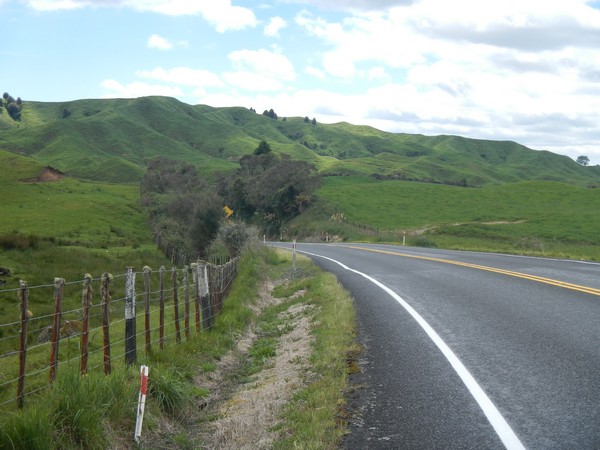
I was on my second hill when I felt, more than heard, a crack and I was then spinning the pedals through thin air – for the first time in my life I had snapped the chain.
When the chain broke it had wrapped itself around the rear cassette and jammed itself between the cassette and the spokes. I had to force it back out and when I worked it free there was not only a break in the chain but also a twist in a couple of the links.
I had the tools with me to pop out the twist and put in new links to fix the chain, but when I measured the chain against the cassette it was too small for the gearing and I was afraid that I would damage the rear hanger as it would be forced up into the body of the cassette. There was only one thing to do and that was to hitch a ride to the next town and hope that there was a bike shop there.
As I was on a hill I pushed the bike for about a kilometer to a place where vehicles could safely pull in and stuck out my thumb out. After only 1 minute a guy called Andy pulled over to see what the problem was. He was on his way to pick up his kids from school and said that if I was still there when he came back past in 20 minutes he would help me out.
I stuck my thumb out again and it was a bit like fishing as I waited to reel in another ride. A guy passed me in a pickup and waved but had no chance to pull in as there was a milk truck right on his rear bumper. (that’s the way the trucks drive over here) A minute later though I saw him driving back towards me from the opposite direction and he pulled over to see if I was okay.
He was heading for Owhango which was about 10km up the road but said that there was no bike shop there and the nearest would be in Taumarunui which was about 30km away. I said that if he could give me a lift to Owhango then at least I would be in a town rather than on the side of the road and it would be a great help. I took my panniers off and loaded the bike onto the back of the pickup and jumped in.
The guy’s name was Dave and when I got in I thought he was homeless as he seemed to have all of his belongings and his dog in the back of the truck. He said that that he was house sitting for a friend and made a living by hauling windblown trees out of the forest and chopping them up to sell the logs to people as firewood. He loved my story that I was cycling around the world and even said that he would drive me all the way to Taumarunui even though the round trip would be nearly 50km out of his way.
Five minutes before I had been stranded by the road with a broken bike and now I was in a truck heading for a bike shop. The generosity of people never ceases to amaze me and this is one of the reasons that I love to travel as it takes you out of your comfort zone as you have to literally live by the seats of your pants. For me, that is when I know that I’m alive.
Thirty minutes later we arrived in Taumarunui and Dave turned the corner into the street where he said the bike shop was located and pulled up outside a Honda dealership with a line of quad bikes outside. There was nothing else in the street and Dave could see the quizzical look on my face and told me not to worry as the guy inside could fix bikes.
I unloaded my bike and panniers from the back of the pick-up and asked if I could take a photo of him. He jumped out with his dog and I took a photo.
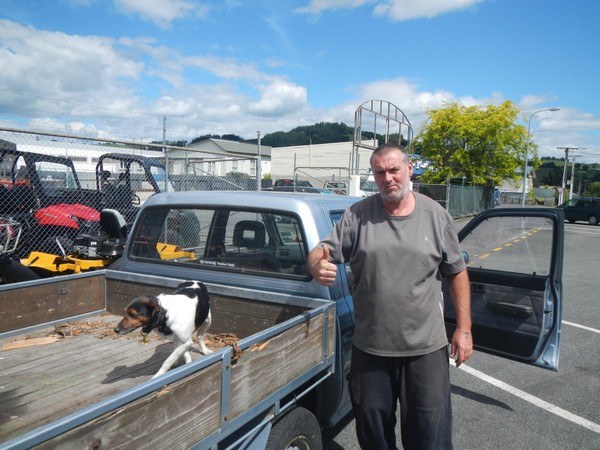
I went to shake his hand and as we did he had 20 NZD in his palm and told me to take it and get myself something to eat. I told him that I couldn’t take it and needed to give him some money for petrol. He was not having a word of it and told me that he had just sold a big load of wood and had money at the moment. He then drove off and left me on the side of the path in front of the Honda dealership.
I walked into the shop and in the corner there was a small bike workshop. I explained the problem to Craig who worked there and he set about fitting a new chain for me.
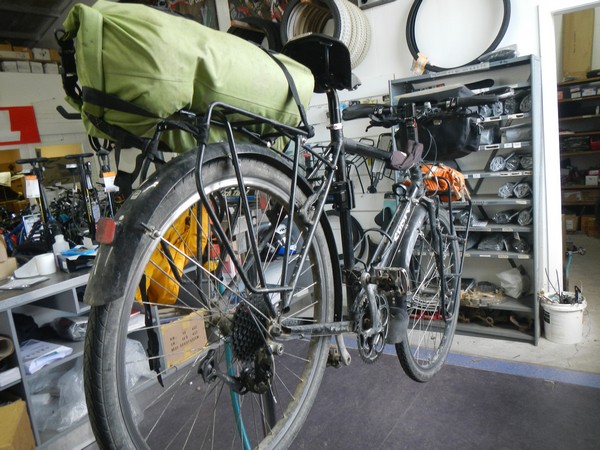
As I was now nearly at the end of the New Zealand leg of my bike ride around the world I asked Craig to give the bike a once over to check that everything was in tip top condition before I headed to South America.
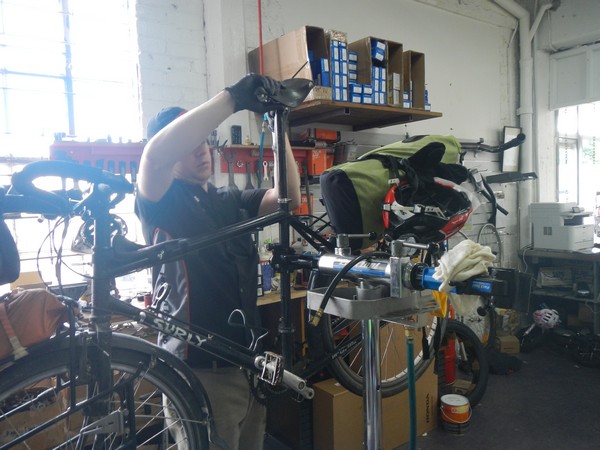
He checked the wheel and cranks and said that the bearings were fine. The bearings on the head were badly worn though and would need replacing as when you rotated the handle bars through their full arc there was a definite groove where they just stuck in the forward position.
The adjuster on the gear shifter for the the front mech was also stuck, probably rusted tight as I had never used it, and would need to be taken apart and greased to free it. Not bad seeing that I had by now covered 8000km.
Craig said that he would need to order in the head bearings and that it may not arrive for a couple of days. I said that it was okay and I would head to a campground and bring the bike back in when the parts arrived.
After being up at 4.30am to hike the Tangariro Crossing and then having broken down it had been a very long and fairly emotional roller coaster of a day. I headed for the campsite which was about 5km back in the direction that I had come from.
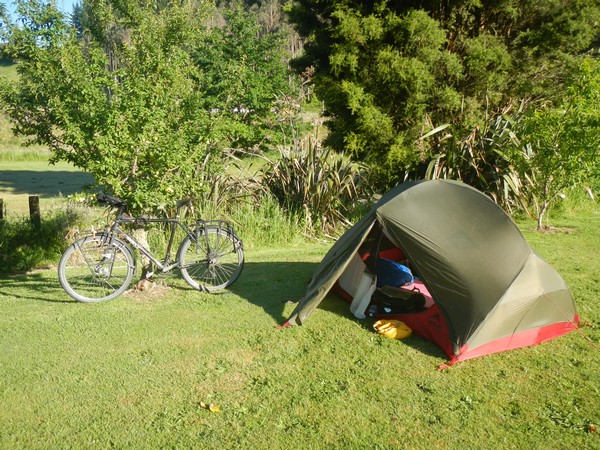
The campsite was the first official place to camp once cyclists came off the Timber Trail and so I had alot of good company for the next couple of days. I had set my tent up next to an English/French couple who were called Jill and Bernard. (and yes like nearly every French cyclist I had met they too carried cheese and crackers with them on the bike)
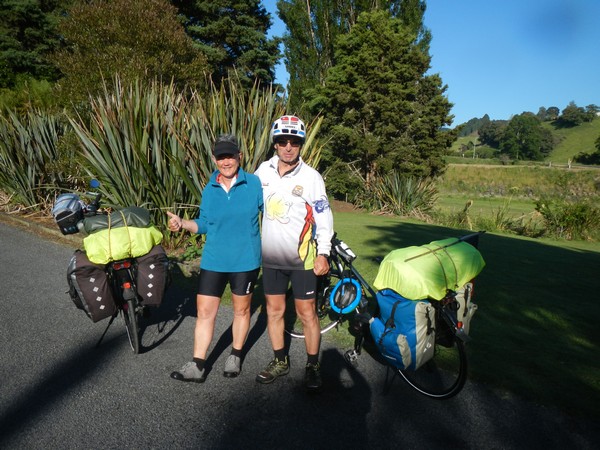
They were in their 50’s and loved tour cycling. These days though they found the hills tough going and so cycled on electric bikes where they could use the motor to boost them up the hills when needed. They said that the range of the battery was good for 70 kilometers on normal roads before they needed to be recharged.
The only downside to the bikes they said was that they were impossible to ride when the battery was flat. Even though they were cycling electric bikes they were cycling the old fashioned way without any electronic equipment and just used a cycling book for route information etc.
Another cyclist that I met at the campsite was Glen who was just in his first week of his cycle through New Zealand.
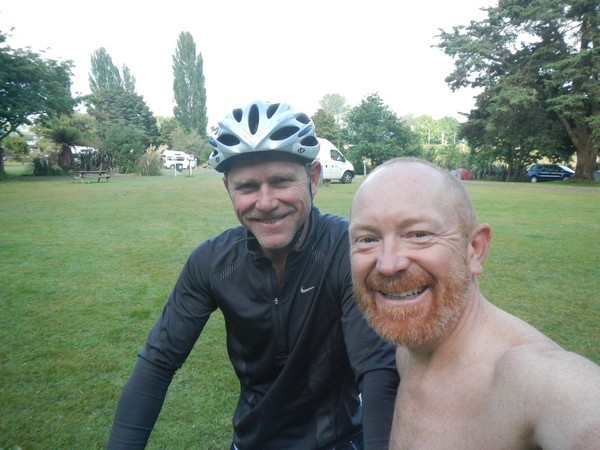
He had come down the Timber Trail and was suffering from a very sore rear end as his body got used to the pounding that you take when cycling a loaded touring bike down a mountain bike track.
Another couple that I met who were on their own amazing adventure were John and Florane (Click here) who were paddling their way around the world in a kayak.
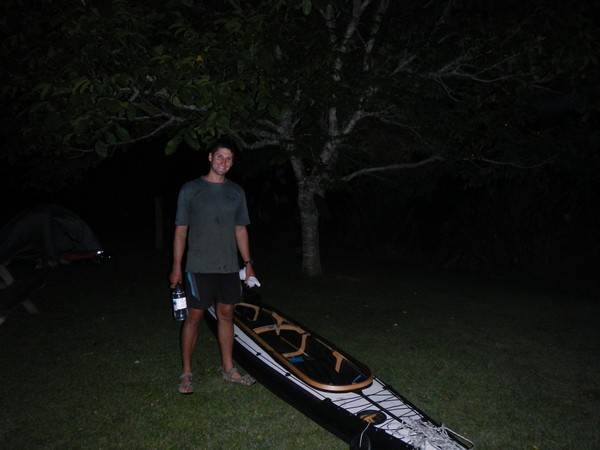
The kayak came in kit form and packed down into two bags when they had to transport it from one river to another. They were nearly at the end of their journey through New Zealand and would be heading to Lao next to paddle the Mekong River through Lao, Cambodia and into Vietnam.
As I was surrounded by such interesting people, who each had great stories from their own adventures on the road, Taumaranui would be a great place to hang out for a couple of days until my bike was fixed.
The next morning when I checked with Craig the parts that I needed would not be there until the following day so I had a day off the bike and after breakfast I cycled the 5km from the campsite to the town centre as there were a few jobs that needed doing.
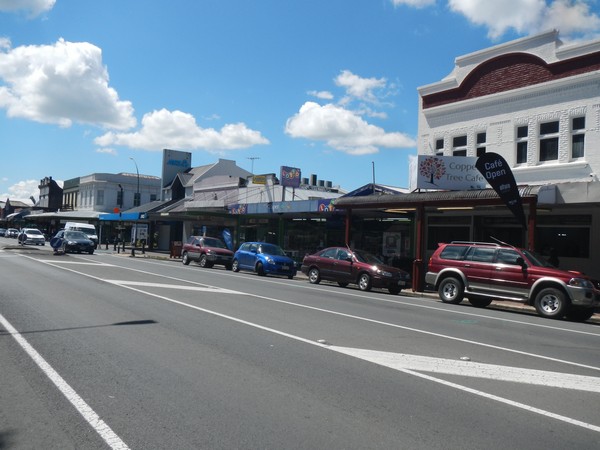
First job was to find a nice cafe for a coffee and a snack and the Copper Tree fit that bill:
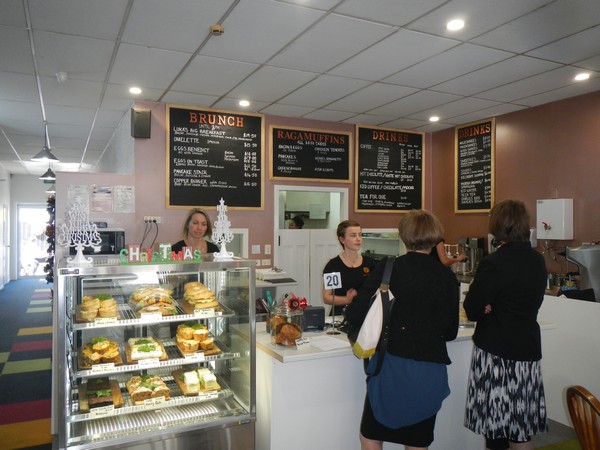
There are so many temptations on the North Island as compared to the South Island that if I wasn’t careful my budget could easily get blown over the next couple of weeks. The cost of things soon adds up – 10 NZD for a couple of coffees, 8 NZD for a snack, 15 NZD for lunch, 17 NZD for the campsite plus add on another 20 NZD for dinner and before you know it you have spent 60 or 70 NZD (about 40 GBP).
I don’t have a fixed budget that I stick to but I try to average around 20 NZD per day. To do this I wild camp, eat porridge and instant noodles for breakfast and lunch and brew my own coffee. Dinner is the one meal that I tend to eat out when in a town otherwise I survive on noodles and dehydrated food, but even that can add up to nearly 10 NZD per serving.
Once I had finished at the Copper Tree I cycled around the town centre to try and find something to do for the day but the town seemed to be a hub for services that supported the farming community rather than tourists and within 10 minutes I had worked out that there was not that much to do in the town.
There was a Mcdonalds though and I cycled there to use their wifi. The cheapest thing on the menu was an icecream cone which costs 1 NZD so I ordered one of them and settled myself at a table near a plug and spent a couple of hours updating my blog.
Around lunchtime I headed to the park to get the stove fired up for my usual lunch of a couple of packs of instant noodles and a pot of tea. The sun was shining and it was a great day to enjoy a day off.
After lunch the last job of the day was to head to the supermarket to pick up some supplies because hopefully the parts would arrive the next morning and then I would be heading for the start of the North Islands premier cycle track ride – The Timer Trail. As I had use of a kitchen back at the campsite I picked up a steak and a bottle of wine for dinner.
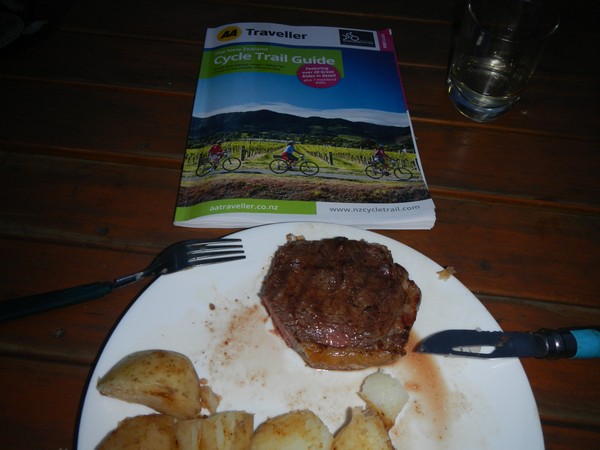
The next morning when I phoned Craig the good news was that the parts that I needed had arrived and so I packed my tent up and cycled back into town to drop my bike off. Craig needed a couple of hours to get everything done and so I headed back to Mcdonalds for a 1 NZD icecream and to use their wifi.
I met a young German couple who had just finished the Timber Trail and they gave me some tips on the best places to camp along the trail and said that I was best avoiding the free D.O.C. site at Piropiro as it was full of organised groups who were cycling the trail.
At 11am I went to see if my bike was ready and Craig had managed to get everything done and my bike was ready to roll. It had a new chain, a new gear shifter adjuster and cable, new top and bottom bearings in the headset. I was 230 NZD poorer but at least the bike should be fine for a few more thousand kilometers.
When I arrived at my friend Alison’s place in a week or so’s time I would strip the bike down and give everything a good greasing before packing it up to fly to South America.
It was now time to get on with the job of cycling to the start of the Timber Trail which was in the town of Ongarue that lay 25km away. I could cycle down the main highway that ran parallel to a branch of the Whanganui River but the German couple that I had met the day before had told me to take a track on the other side of the river that would lead me to a gravel track and the start of the trail.
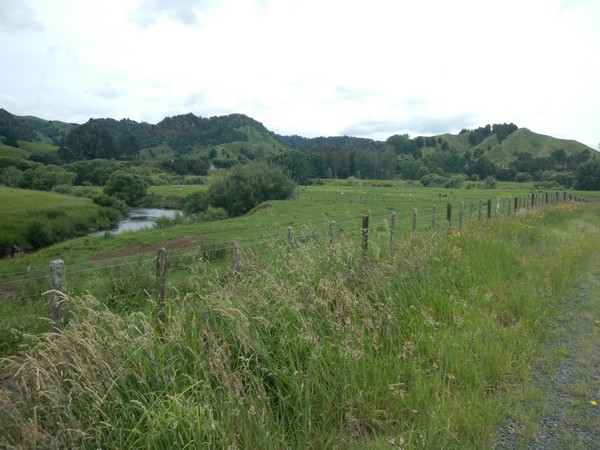
The track was pretty rough in places but so much better than cycling on the main highway. In front of me I could see the hills that formed the boundary of Pureora Forest where the trail threaded it’s way through.
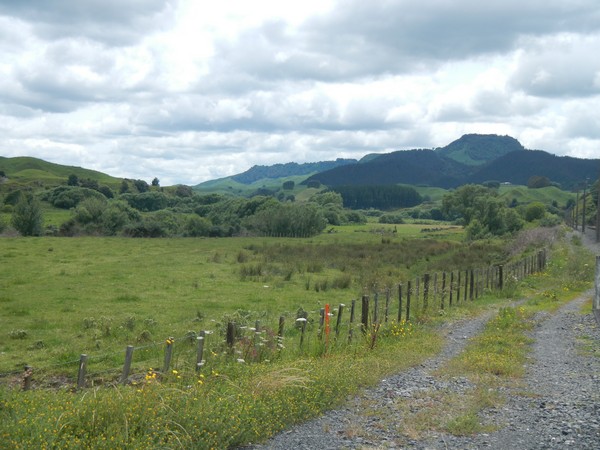
After a 90 minute ride the track that I was following led me to the start of the Timber Trail and I was ready to tackle the jewel in the crown of off road tracks that the North Island offers.
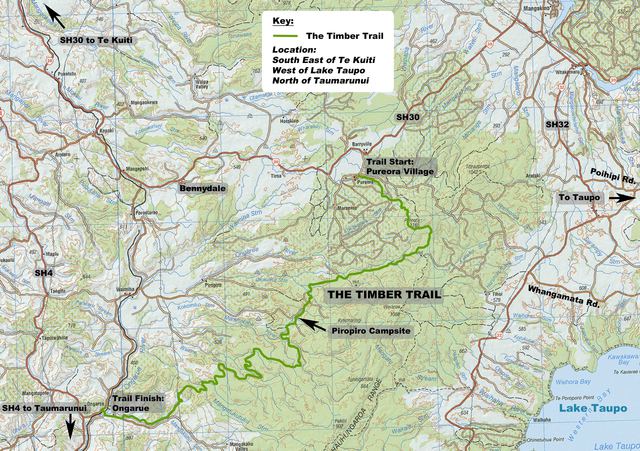
99% of riders start the trail from the other end at Pureora Vilage as that is the highest point of the trail at 965m. They then descend down to Ongarue, where I was starting, which lies at less than 200m.
I was once again doing the trail in the wrong direction on a fully loaded touring bike but the silver lining was that as I would be climbing for most of the next 82km of mountain bike trail my bike and panniers shouldn’t rattle apart by the time I reached Pureora.
The section of track from Ongarue to the half way stage at Piropiro campsite follows an old logging tramline which was constructed and operated by the saw milling firm Ellis and Burnand to bring trees out of Pureora Forest.
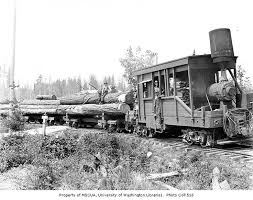
The line was closed in 1958 and left abandoned until in 2009 the route was included in the NZ cycle ways project. The first section of the trail rises fairly steeply from Ongarue. On one side of the trail I had beautiful views of the valley as I climbed my way towards the heart or Pureora Forest
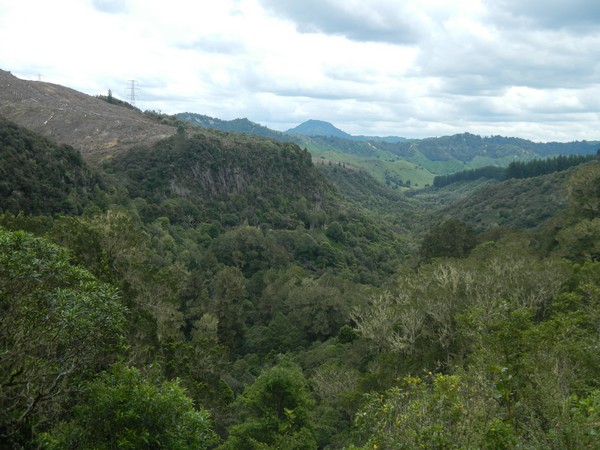
On the other side was a cliff wall where the tramway had been cut into the hillside.
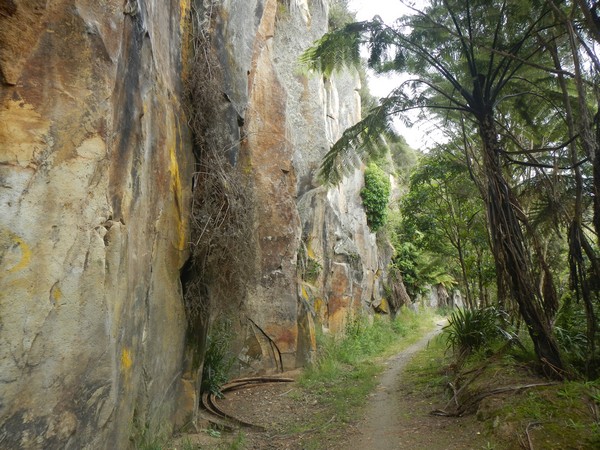
After an hour of steady climbing the trail came to a place known as The Spiral.
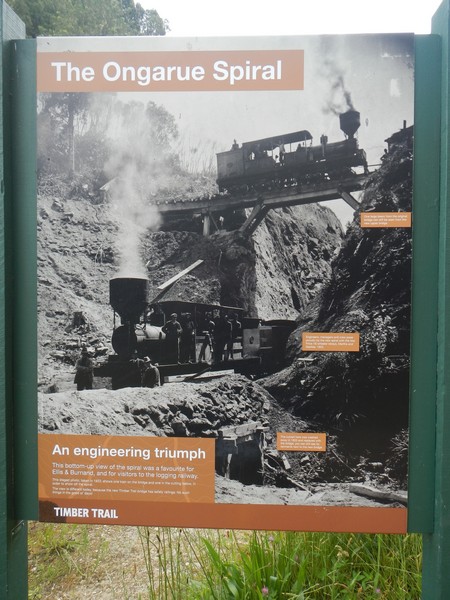
There is a 43 metre cliff section here that the tramway needed to negotiate and so they tunneled through the side of the mountain and built a track spiral at a gradient that the trams could cope with.
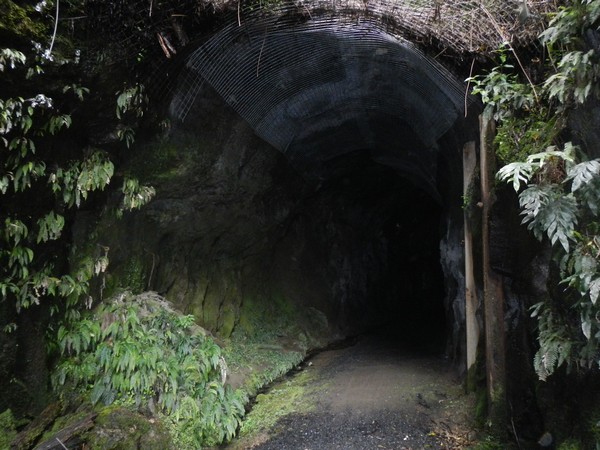
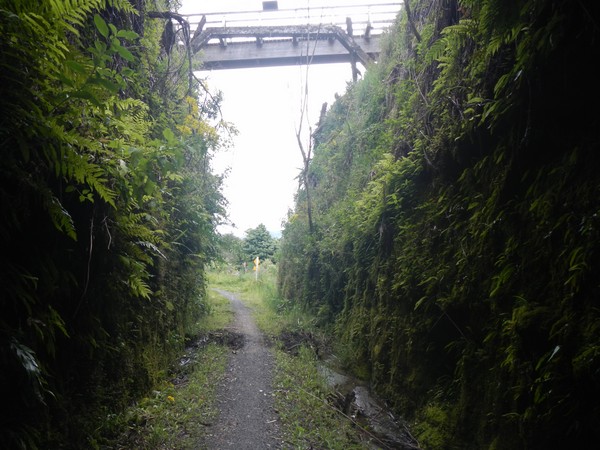
The trail entered the forest area at this point and the track changed to dirt which was more suited to mountain bikes rather than the touring bike that I was riding which had road tyres on.
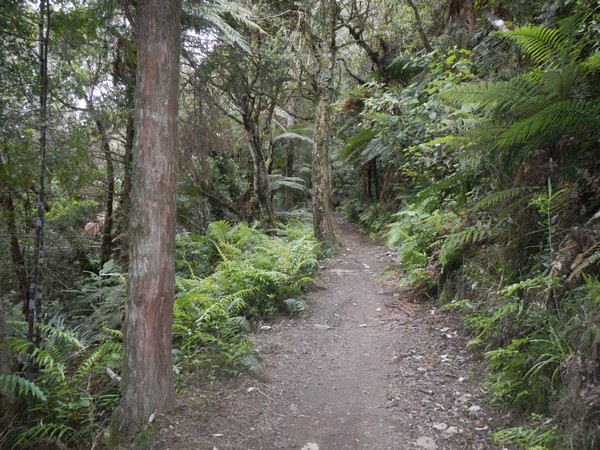
Still, it hadn’t rained all day so the track conditions were still easily negotiated.
To span the valleys suspension bridges have been constructed to replace the original tramway bridges that had mostly rotted away.
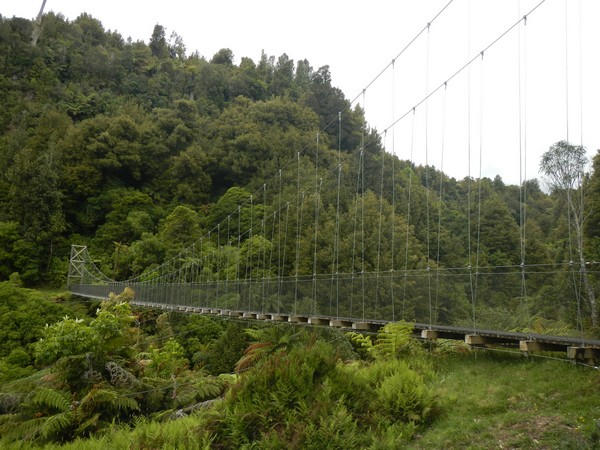
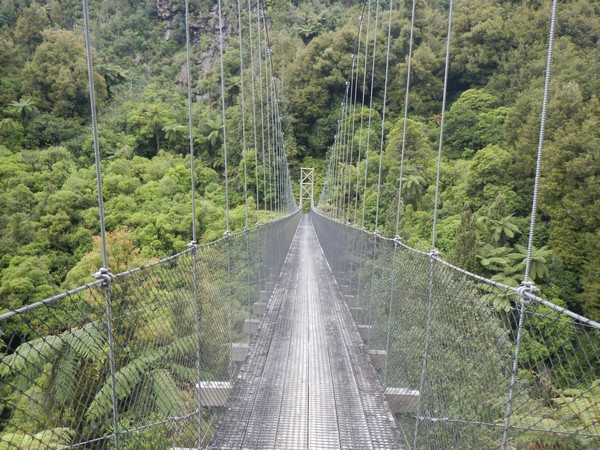
The longest of these is 141m in length and stands at a height of over 50 m above the river which flows through the valley below.
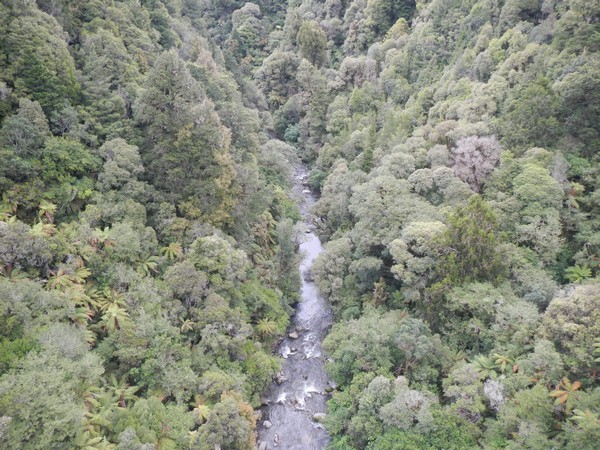
I had now been riding the trail for a couple of hours and it was time for food. The trail is also used by trampers (hikers) and every 10km or so storm shelters have been constructed which can be used to either sleep in or just to get out of the rain.
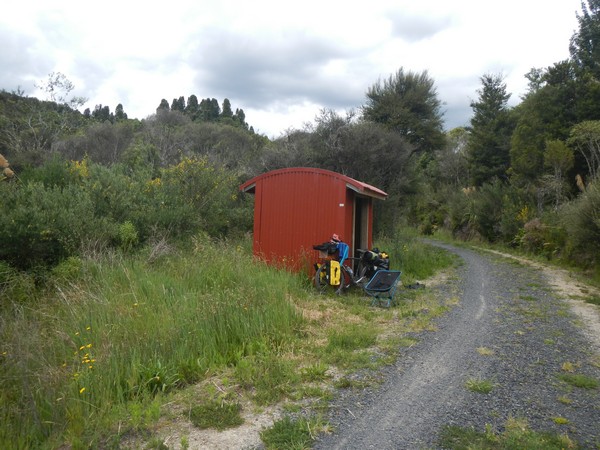
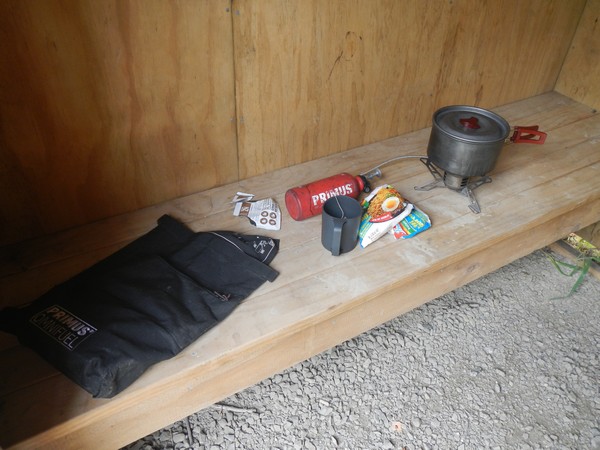
After a quick bite to eat I only had 20km left to get to Piropiro where there was a campsite that I could sleep at or, if the weather held out, I could press on for another few kilometers to find the place that the German couple had told me about.
This section of the forest was full of ridge lines but as the trail followedg the route of the old tramway cuttings through the ridges had been dug out which mean’t that for me there were no real steep inclines to negotiate as I continued my steady uphill climb.
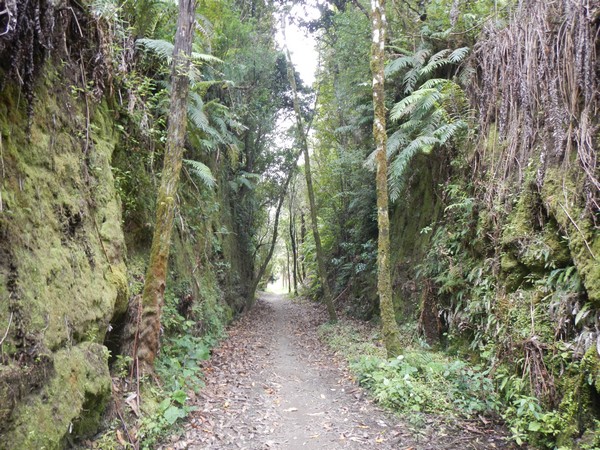
I then reached the Maramataha River which lies at the bottom of a deep canyon area. This was my only downhill section of the day. It also marked the end of Ellis and Burnand’s tramway line as there was no way that the tram line could negotiate the canyon area.
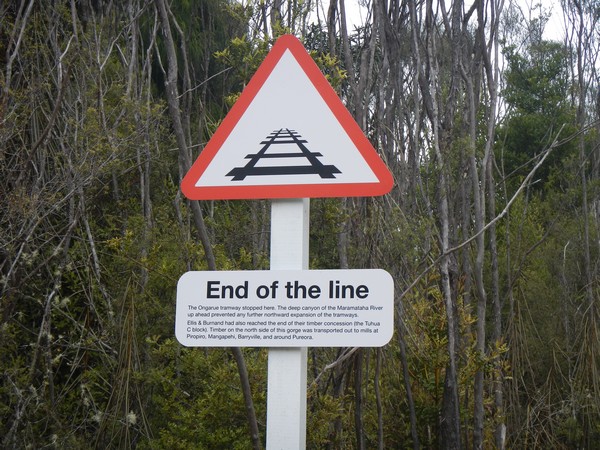
Timber that was felled further on in the forest was transported to sawmills near to Piropiro which lay about 10km ahead of me.
The steep decent into the canyon was followed by a steep climb back up on the other side of the valley.
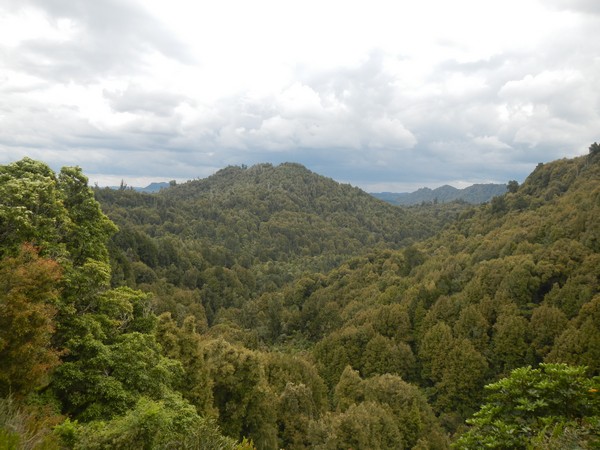
Once I had reached the top of the canyon area the view back down the valley showed how remote the forest area that I was cycling through really was. In a way I was glad that my chain had snapped when it had as there was no way that I would be thumbing a lift out of here. If anything happened it would mean one hell of a long walk out.
I was now cycling past the campsite area at Piropiro and as the weather was still dry I pushed on to find the place that the German couple had recommended. After a couple of kilometers I came across the ford in the river that they had told me about and there were 3 or 4 grassy areas that I could set up my tent next to it.
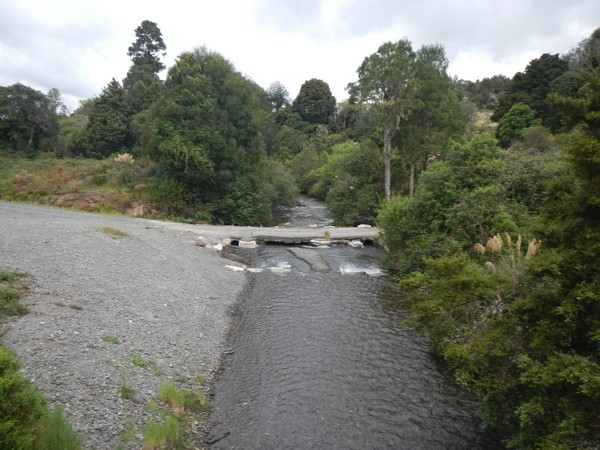
I decided to call this place home for the night and got a pan of water on to have a wash before I sat down for dinner.
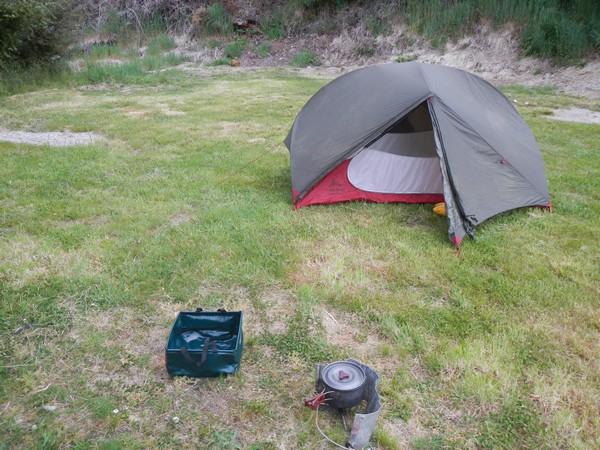
It had been a great day on the bike and as I had the place to myself I lit a fire and as the sun went down I sat and ate my dinner as the flames danced away to keep me warm.
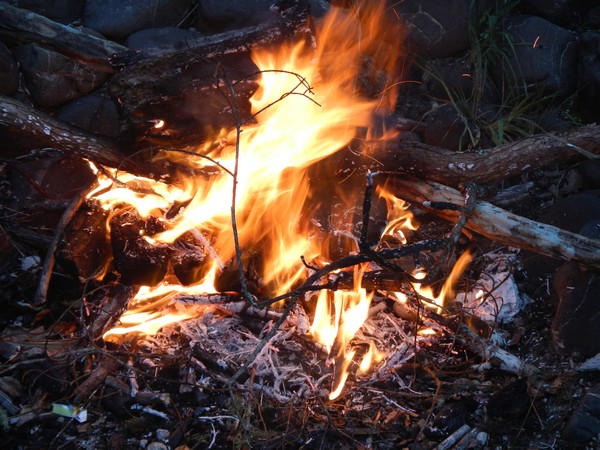
Here is a video that I shot along the way:
The next morning I woke to the sound of the rain drumming down on top of the tent. This was the last sound that I wanted to hear as I knew that the last 40 km of the Timber Trail was the steepest and muddiest section of the track. If the rain continued I was going to have one hell of a day on the bike with the road tyres that I had on the bike.
I made breakfast in the tent as I waited for the rain to stop.
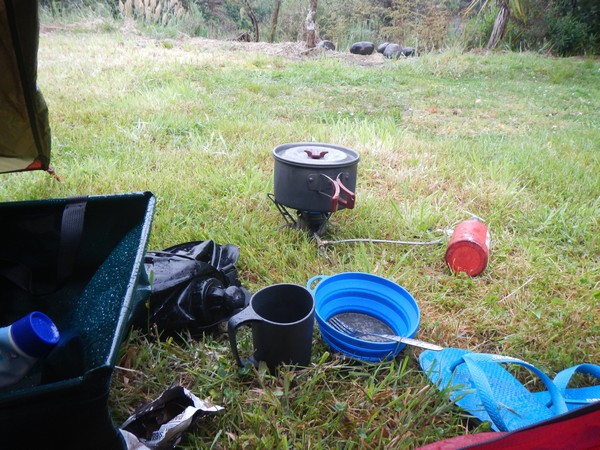
The rain thought about stopping a few times but never quite did so. After an hour of waiting I threw on my wet weather gear and packed the tent up and headed off on the steepest section of the Timber Trail. Day 1 had been along an old tramway that had been used to run a railtrack to haul the wood out of the forest. That track finished just before Piropiro and today’s track was a pure mountain bike track that had been cut through the forest whose surface was primarily mud.
The overnight rain had made the track very tricky from the get go as my tires were not built to handle wet muddy conditions and lacked the knobbly tread that I needed to get enough grip to ride uphill.
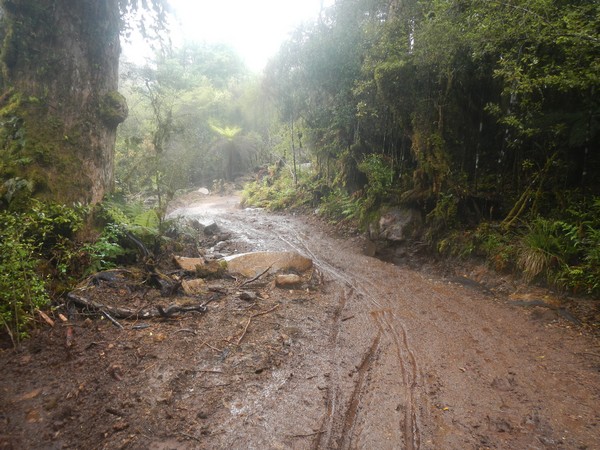
The rain continued to fall and the only way to get up the steepest sections was to push the bike as the back wheel was just spinning in the mud.
The downhill sections were also tricky as the front wheel would just slide out on corners, especially if there were tree roots. I came off a fair few times but it made for a great days cycling and was brilliant fun.
The track continued to climb all day and I wasn’t sure if it was now raining or whether I was just in the clouds. It was that miserable ‘irish’ drizzle and as the wind had died it didn’t seem to lift. After a couple of hours I pulled over at a storm shelter to get lunch and have a break from the rain.
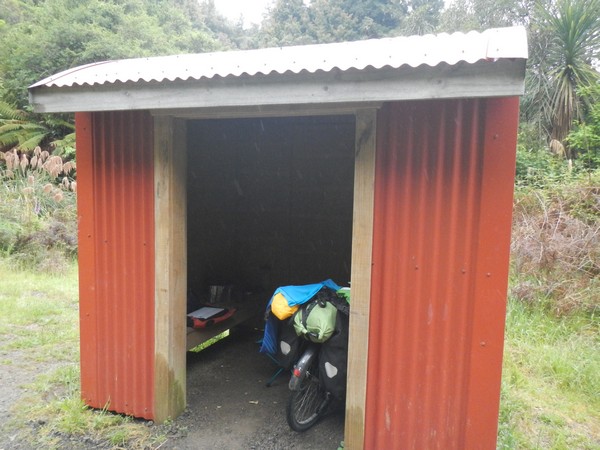
At least it was dry I set up the computer to catch up on my blog and to wait and see whether the rain would lift.
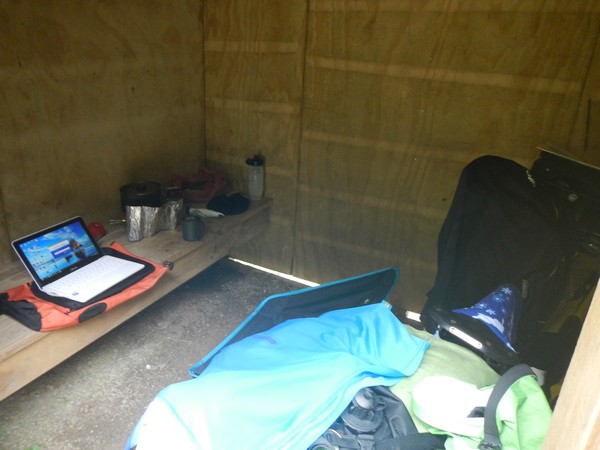
Guess what? It never did and the track continued to deteriorate as I climbed my way up to the highest part which took me over Mount Pureora.
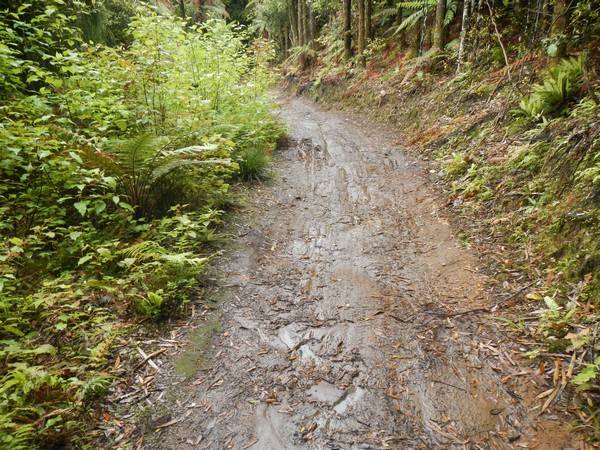 I could see why this track had gained the reputation of being one of the premier tracks on the north island and there was a steady stream of riders coming down the track past me. The views weren’t great though as the track was through dense forest but there were once again many swing bridges across the deepest river valleys which gave me a good view of the forest landscape that I was cycling through.
I could see why this track had gained the reputation of being one of the premier tracks on the north island and there was a steady stream of riders coming down the track past me. The views weren’t great though as the track was through dense forest but there were once again many swing bridges across the deepest river valleys which gave me a good view of the forest landscape that I was cycling through.

I had climbed my way over Mount Pureora and had reached the point in the track that I was so looking forward to – the 12km marker post.
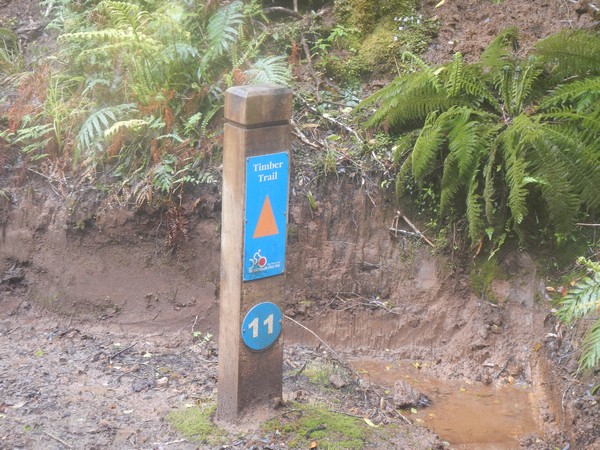
I was so excited that I forgot to take a photo of it so took a photo of the 11km marker instead. The 12km marker was the point that the track started to descend in my favour and I had an easy run down to Pureora village where the track ended.
I was now out of the forest area and into a section of heath-land. For the first time that day I now had a 360 degree view of the landscape around me and could see the ‘cloud soup’ that I had been cycling through.
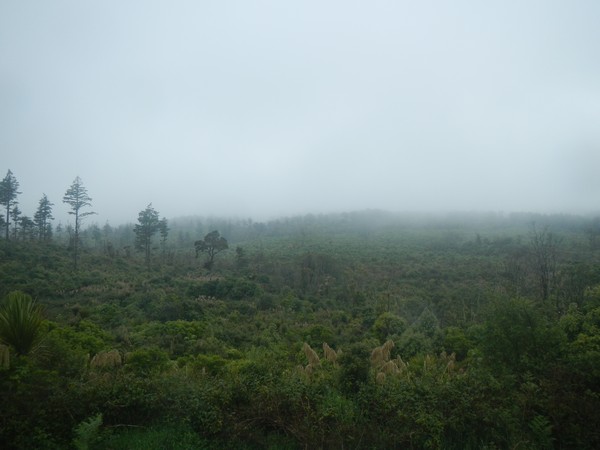
Another couple of kilometres of descending and I reached a D.O.C campground area that marked the head of the trail. 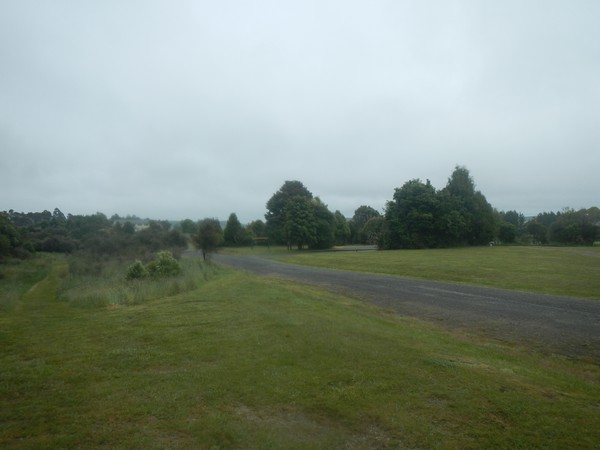
That was it – I had completed the off road trail that was at the top of my list for trail rides on the North Island and can see why it had gained the reputation that it had. If I ever came back to New Zealand then I would definitely love to ride it again on a mountain bike from the correct direction as the people that I had passed that day coming down the trail were covered in mud as they flew down the track.
It was nearly 5pm and I could have camped at the D.O.C site at the end of the trail but there was a town called Mangakino around 30km away and I decided to head there as everything I owned was now wet and hopefully there was a launderette where I could put everything in the dryer.
Here is a video I shot along the way:
It had taken me nearly 7 hours to cycle the last 40km of the Timber Trail but now that I was back on tar sealed roads the 30km to Managakino only took me 90 minutes to cycle.
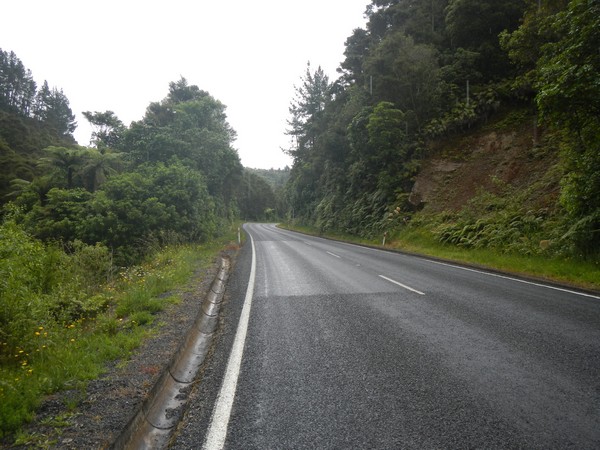
First stop when I got to town was the laundromat to get my stuff dried. As my cycling clothes were now muddy from falling off so much on the trail I stripped off and put on my wet weather gear and threw every single item of clothing in the wash and headed to a bar for a pint while it washed.
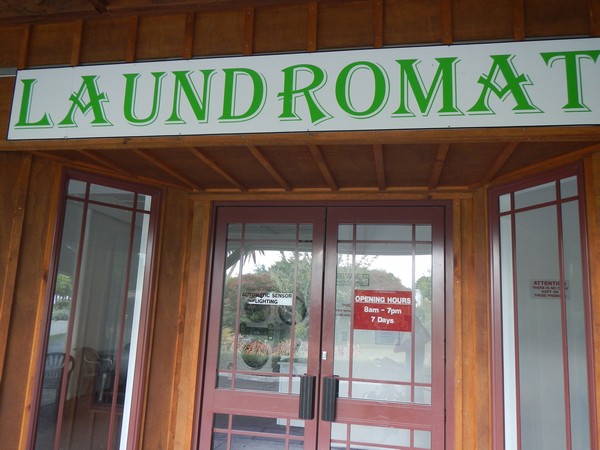
I must of looked a bit weird sat in the bar with my waterproofs on but I didn’t care.
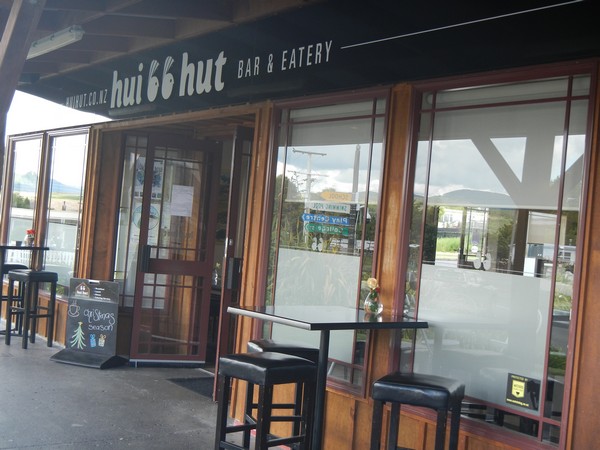
The wash took 30 minutes and as everything that I own is quick dry and light weight it only took 15 minutes in the dryer which gave me time for a couple of beers. It was a fitting end to a fantastic couple of days of off road cycling.
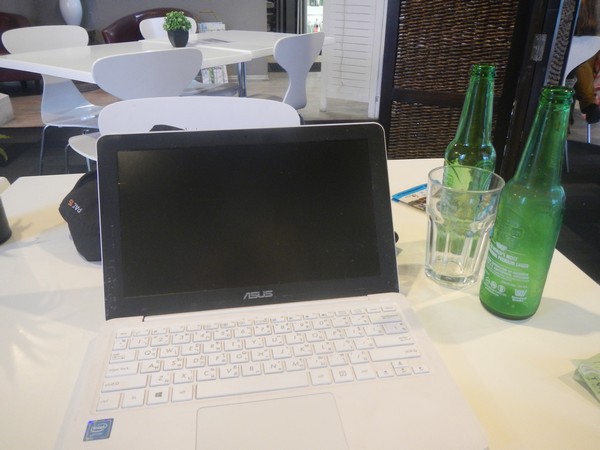
Once I had clean, fresh, dry laundry it was time to set up the tent for the night and I asked in the bar about camp spots around town. They said that people sometimes camped on the shore of the lake so I cycled down to it.
The lake area was a beautiful spot and there was an area of the car park set aside for camper vans. I should have camped there but decided that the lakeside looked more appealing and continued on to the shoreline.
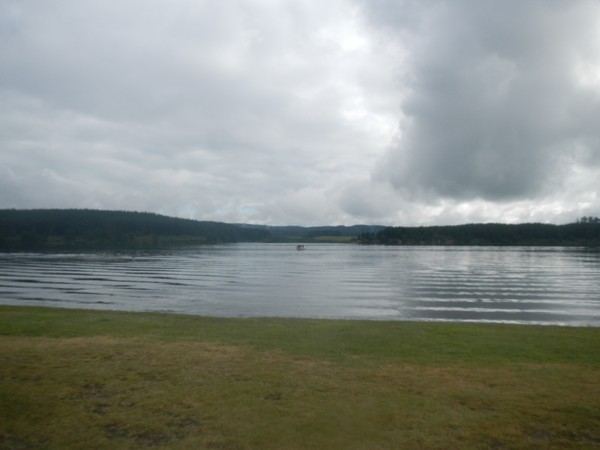
There were very small no camping signs on the pathway that ran around the lake but as the sun was setting I couldn’t imagine that anybody would be bothered if I set my tent up for the night as I was going to be up early in the morning.
The next morning there was not a breath of wind and the lake looked even more beautiful than it had the night before.
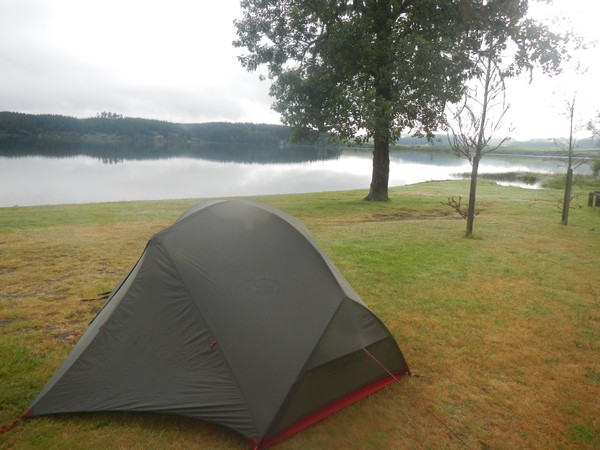
The sun rose as I sat by the lake eating breakfast and there was a mist above the lake which looked spectacular. As it was sunny I was able to dry out all of my gear from the soaking that it had had over the last couple of days.

There was a library in Mangakino and on my way out of town I called in to use their free wifi. There was a private gym next to the library which seemed to be playing the music at full volume which made a mockery of the silence signs that were pinned up around the walls of the library.
The sun was now out and beating down and I took full advantage of it by popping round to the 4 square supermarket to buy a pack of bacon and a loaf of bread to rustle up a couple of bacon sandwiches on the steps of the library.

It was then time for me to head out and pick up my next off road trail – The Waikato River Trail which started about 5km from Mangakino. This was another mountain bike trail and would take me 100km further north towards Cambridge, and put me within a days riding of my final destination of Waerenga where I would finish my cycling through New Zealand.
The previous night I had met a guy in the bar that I had gone to who was a cyclist and regularly cycled the off road trail that I was about to head for. He said that unlike the Timber Trail that I had just finished riding this track had no swing bridges that traversed the valleys but instead there were lots of steep switchback sections that I would need to negotiate. My only hope of completing this trail was that there would be no rain over the next couple of days as if there was I would need to abandon the track.
That afternoon when I set off the sun was shining and I had no concerns about being able to ride the trail as I cycled along the main road the 5km to the head of the trail.
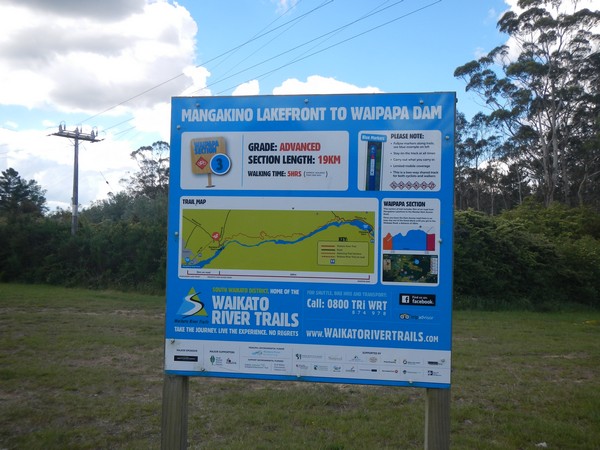
This track was split into different sections with an access road out after each section if you wanted to just tackle a particular section rather than completing the full 100km length.
For the initial few kilometres of the track I was cycling on logging tracks which had been cut through a pine forest.
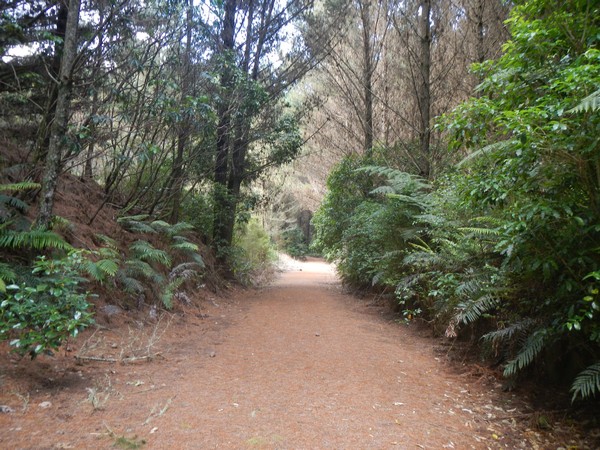
The biggest obstacle was not so much the terrain but the trees that had been blown down across the track.
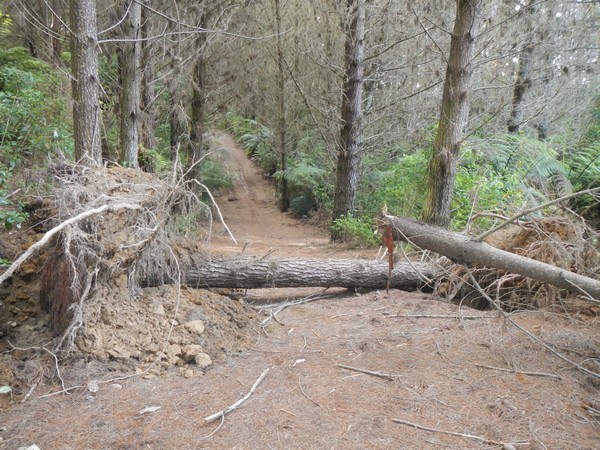
If you have never tried lifting a fully loaded touring bike 2 ft into the air to clear fallen tree trunks I can assure you that it is not easy. I should have really unloaded the bike as the trunks were so high that the teath of the front chain rings dug into the bark as I lifted the bike over some of the fallen trees. There were just too many windblown trees to continually keep stopping to unload the bike though.

The other obstacle along the track were barriers which I think had been set up to stop motorbikes and quadbikes from accessing the track
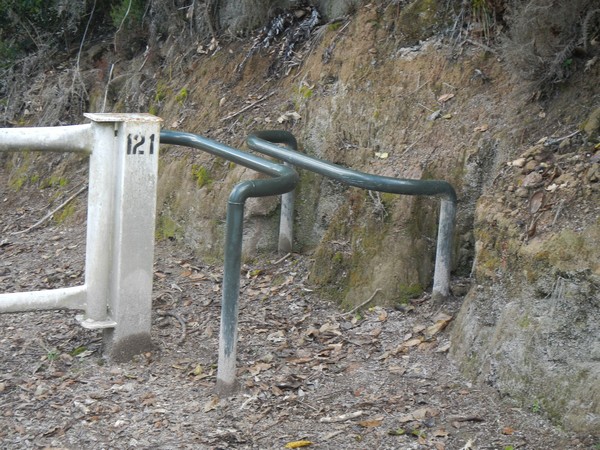
The problem was that the top barrier was too narrow for me to fit my tent bag through which was on the top of my rear rack. The only way that I could get through them was by standing the bike upright on the rear wheel and pushing it through on one wheel. A feat easier said than done when riding a fully loaded touring bike.
The trail is called the Waikato River Trail but for the first couple of hours on the trail the track took me up and over many tributary streams and I never saw the main river channel once, even though I knew that it was always winding it’s way up the valley that I was following somewhere a few hundred metres away to my right.
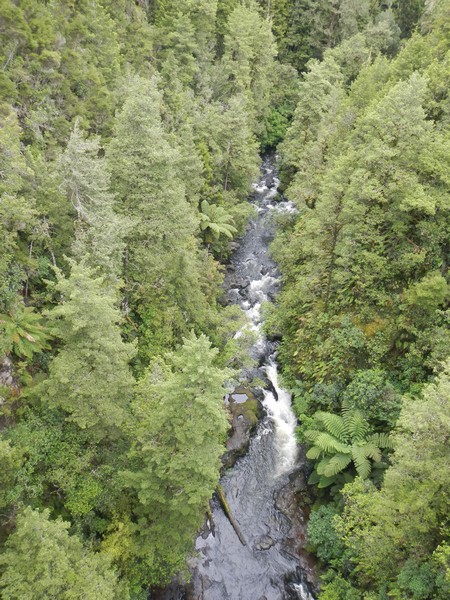
When I found the river though the track stayed next to it for the rest of the day.
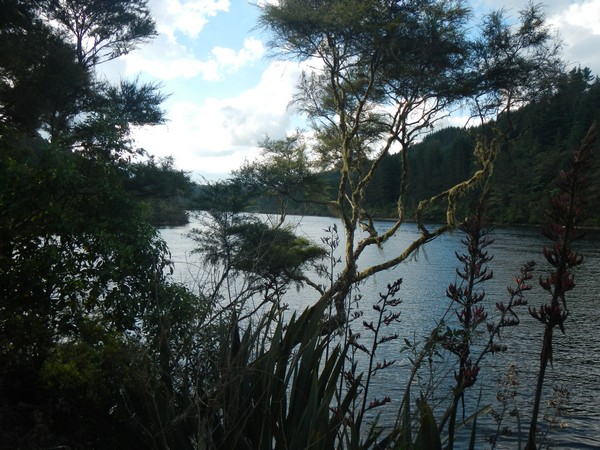
In certain sections they had installed boardwalks next to the river where the valley side was too steep to put a track
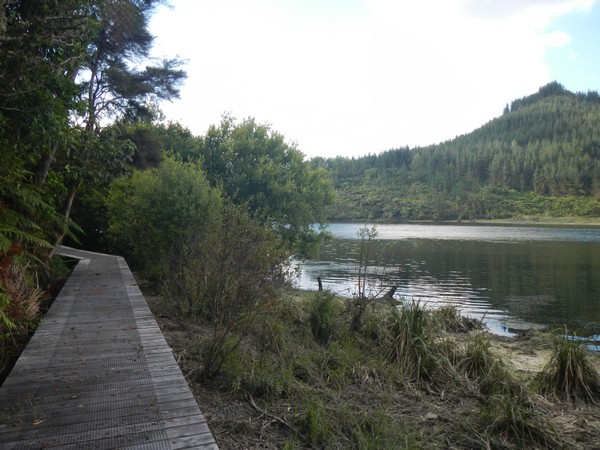 While in other section the track climbed towards the ridge line of the river valley in a series of steep switchbacks.
While in other section the track climbed towards the ridge line of the river valley in a series of steep switchbacks.
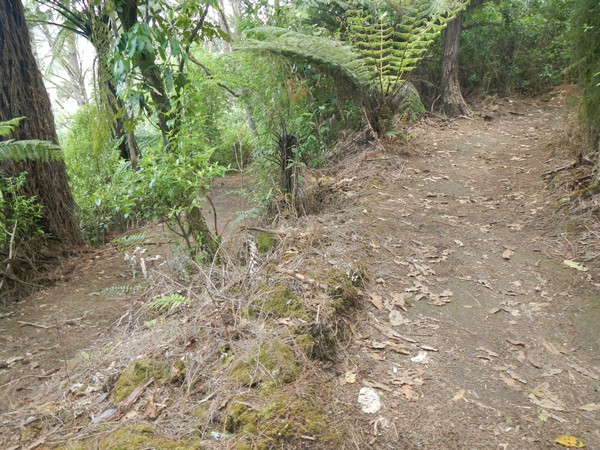
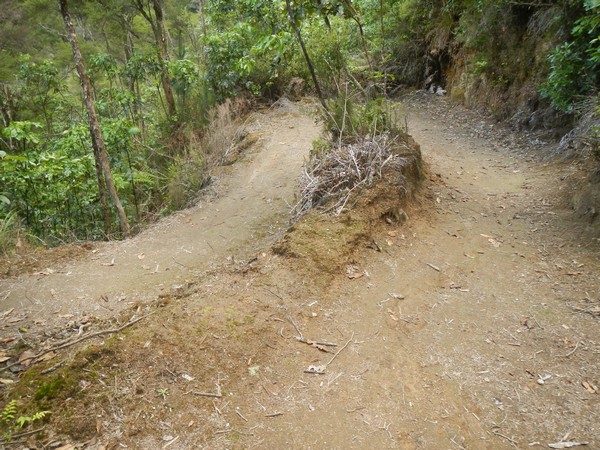
Negotiating the turns on the switchacks was probably the most frustrating part of the days ride as my bike was too long to get around them without me lifting the front wheel to pull it round. This is something that is virtually impossible with two panniers on the front forks, and so I had to cycle into the turn and then get off the bike to straighten it up ready to cycle towards the next turn. A very slow and energy sapping routine which was quite entertaining at first but quickly lost it’s comedy value.
The downhills back towards the river below were more switchbacks but with gravity on my side I could get around most of the corners without stopping; with the extra speed I did lose the front wheel a few times in the loose dirt ending up on my backside on the track.
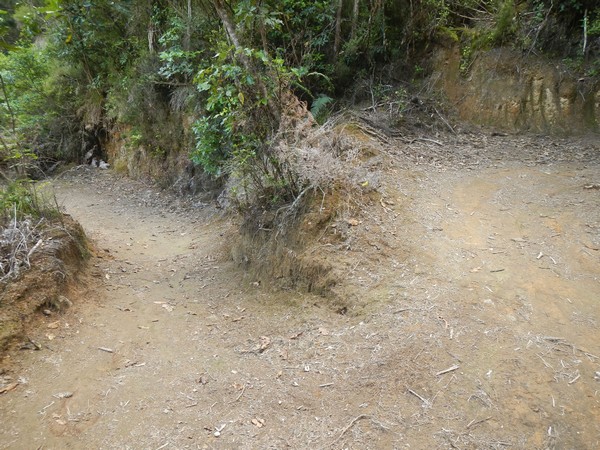
The Waikato River that I was following is a hydro river which is dammed every 20km or so along it’s length. At each of the dams hydro electricity generators have been installed and you can tell when you are approaching a dam as the river significantly widens where a lake area has been formed behind the dam to ensure a constant supply of water to the electricity generating turbines. 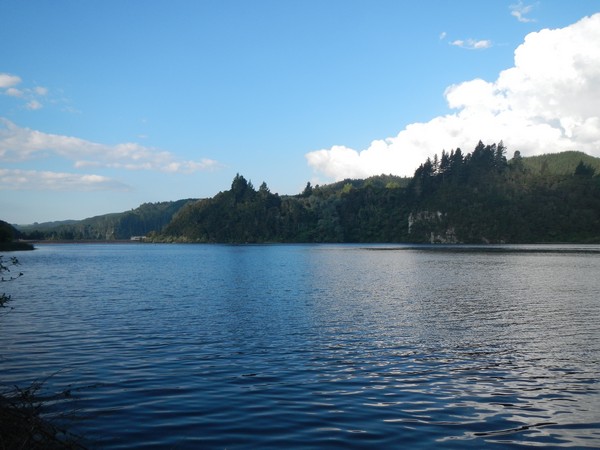
It was passed 6pm by the time I arrived at Waipapa Dam and as there was a flat grassy area next to the dam I decided that it would make an ideal place to put up my tent.
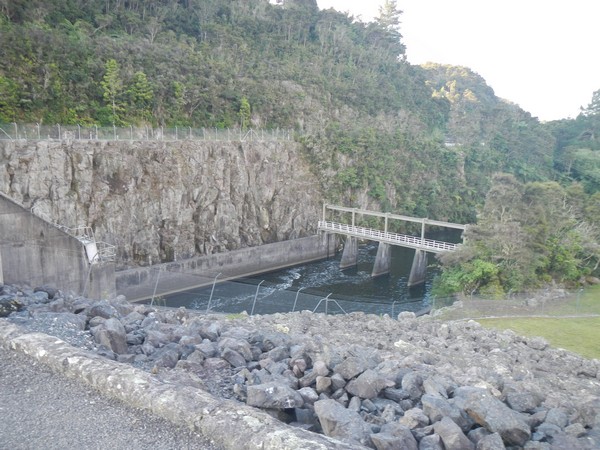
There were security signs saying no access to the dam area but as the dam seemed to be ‘unmanned’ I ignored these and cycled across the dam to access the grassy area. The only problem may be the video cameras that had been set up to remotely monitor the site. I was hoping that where ever the monitoring point was that they wouldn’t be bothered by a cyclist setting up a tent. It wasn’t like I had scaled a fence to get to the grassy area.
Just in case I tucked myself in a side part of the grassy area that couldn’t be seen from the main dam and made dinner and waited for it to go dark before I set up the tent in case a security guard turned up and threw me off the site.

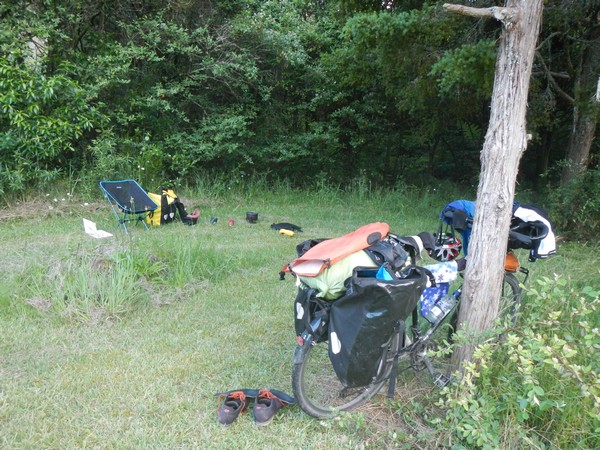
The next morning my worst fears came true when I woke to the sound of rain on the roof of the tent. This would make the next part of the track impossible for me to ride as the profile of the ride showed that there was a 300 – 400m elevation gain over a 3 km distance and would mean that I would be pushing the bike for much of this.
I decided to abandon this section and pick up the track further down the river valley. It turned out to be an inspired choice as when I cycled down the access road back to the main highway the heavens opened and there was a torrential downpour.
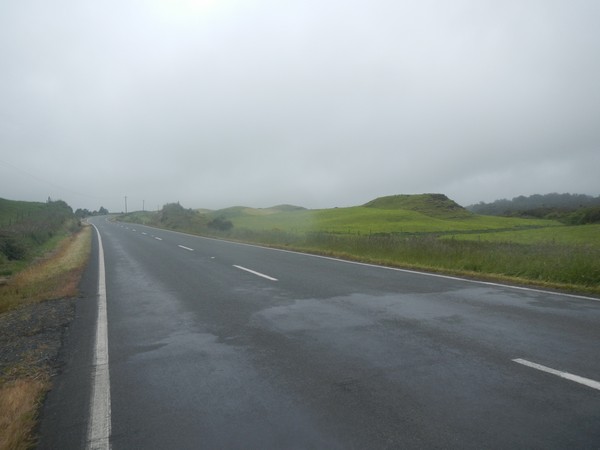
I checked the map and the next point that I could pick up the river track again was at Arapuni Dam which was 35km away by road. I had to still cross the ridge line that I would have had to cross if I had stayed on the river trail and was glad that I hadn’t attempted to ride it on a mud track given the height of the ridge in front of me.
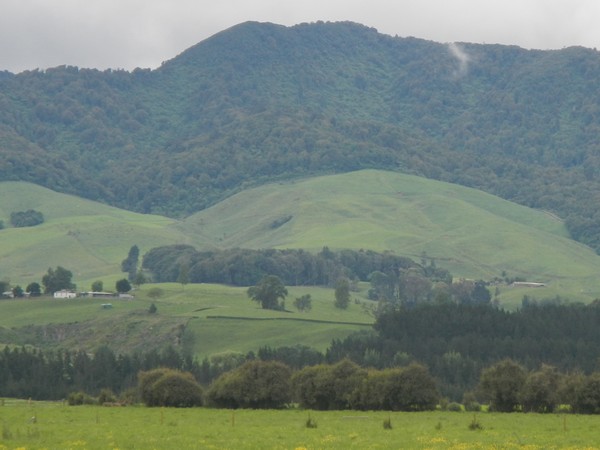
I reached the dam at Arapuni in a couple of hours and it was one of the tallest of the dams along the Wiakato River.
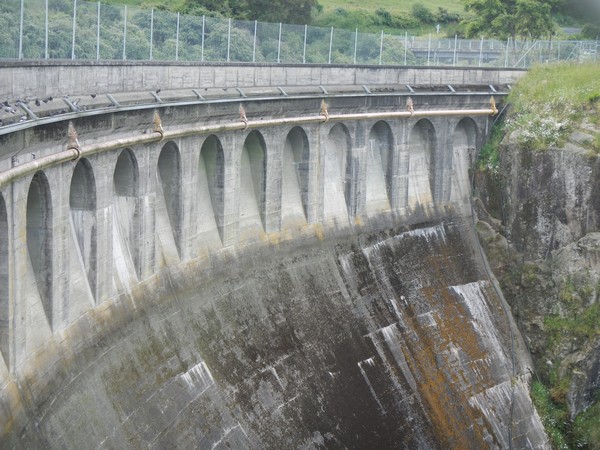
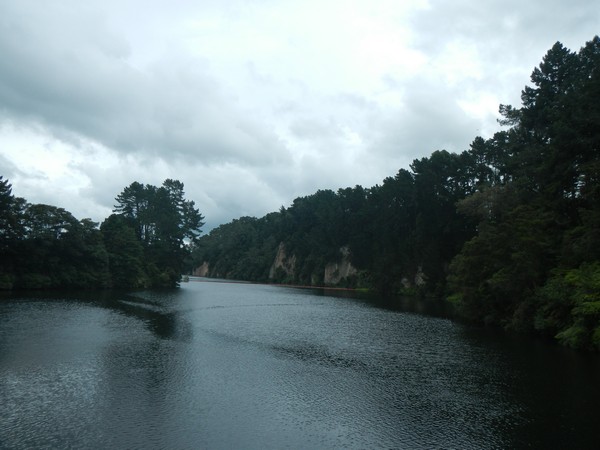
I jumped back onto the track as this section of the river valley was pretty flat and followed the track towards Arapuni. When I arrived there it was still raining on and off so I took refuge at a cafe to see if I could wait out the rain. I ordered a coffee and sat down at a table next to a plug socket and plugged my phone in to charge it while I waited for the coffee to arrive.
The owner delivered the coffee and took exception to my phone being plugged into the socket and gave me a lecture about how rude I was and that in New Zealand it was polite to ask. She then walked outside and shouted at a group of cyclists who had just arrived and had parked their bikes in the cafe courtyard instead of parking them in the bike rack outside. I think that she was having a bad day.
Once the rain stopped it was time to get back to the river and cycle the final 12km of the river trail track towards it’s finish at Pokaiwhenua. This section is graded as easy/intermediate as the are no big climbs on this section as the path winds it’s way through the fields next to the river.
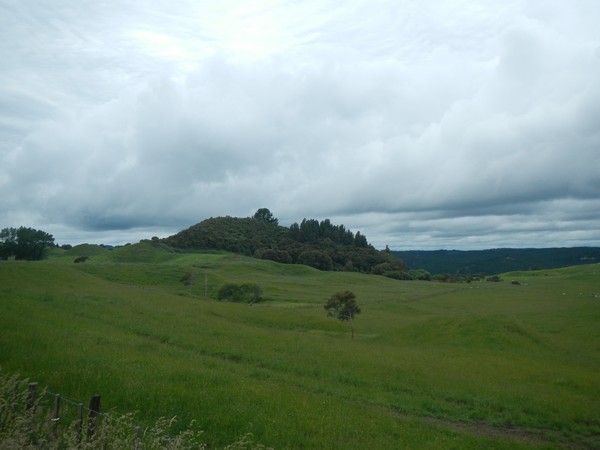
As I approached the end of the track there was an open grassy area called Little Waipa Domain with a sign saying that camping was only allowed by permit. As it was getting late, like at the dam the night before, I didn’t think that anybody would be turning up to check so I pitched my tent right next to the river.
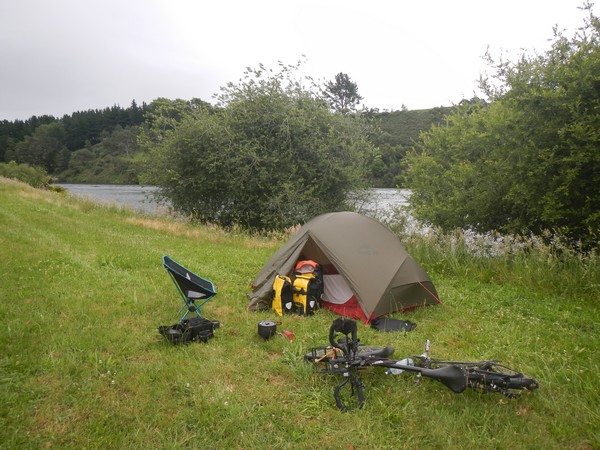
As I was cooking dinner the pattern of the day repeated itself and the heavens opened and dinner had to be eaten in the tent.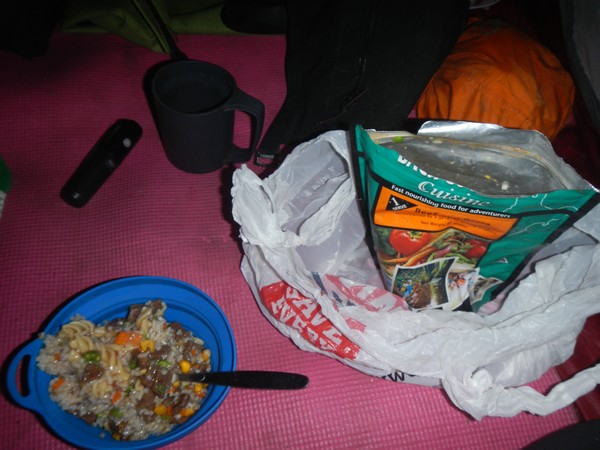
The last few days had been an off road festival and where I camped that night was just 120 km from my final destination near Auckland where I would leave my bike with a friend from university that I had not seen for close to 15 years. However, instead of going directly there I would go in a roundabout route via Cambridge, to do a track session at the velodrome, and Hamilton where I needed to pick up a few things for Bolivia in South America where I would be flying to next.
If you would like to automatically receive all future posts straight to your email inbox please just add your details to the form at the foot of this page.